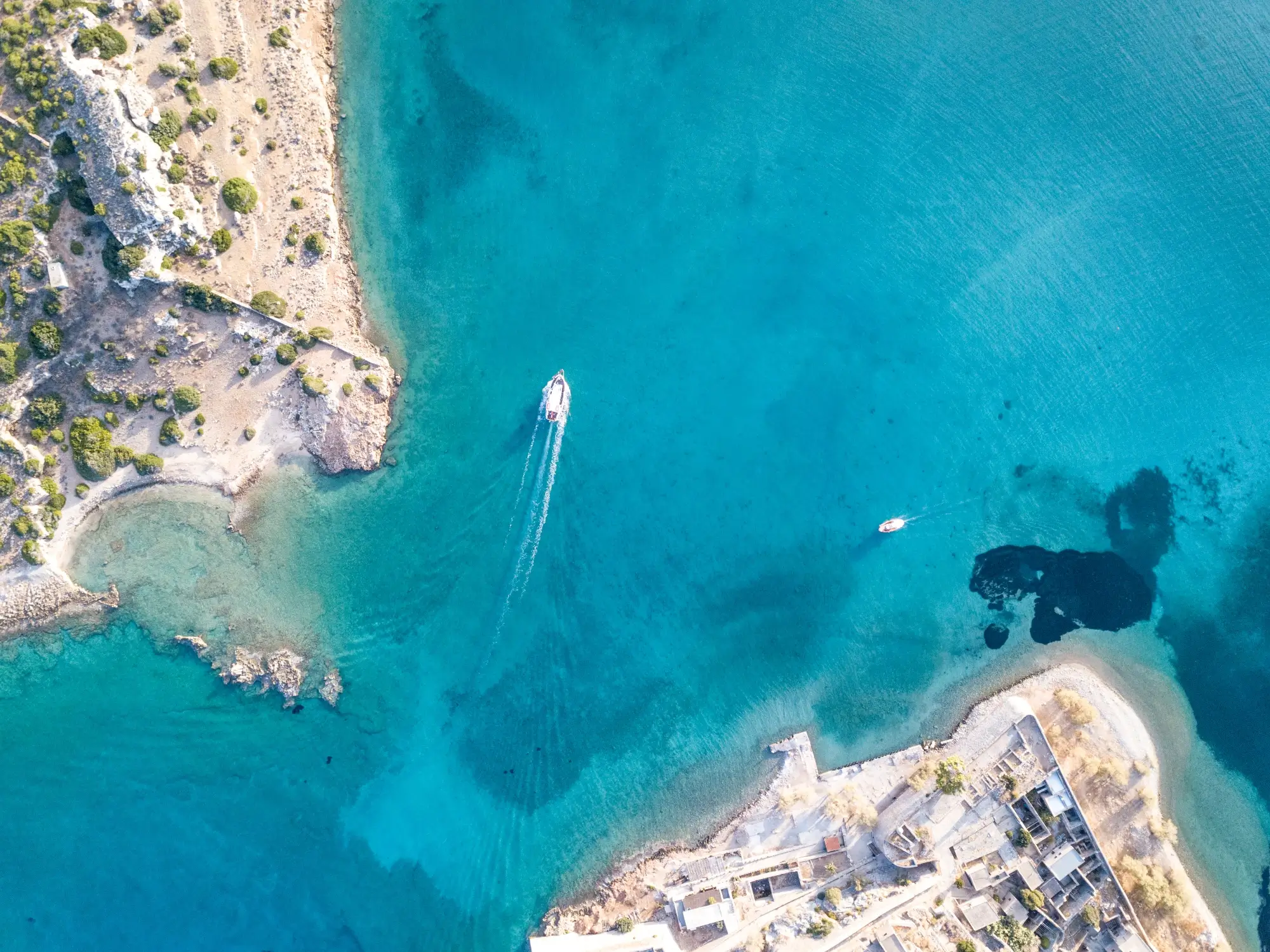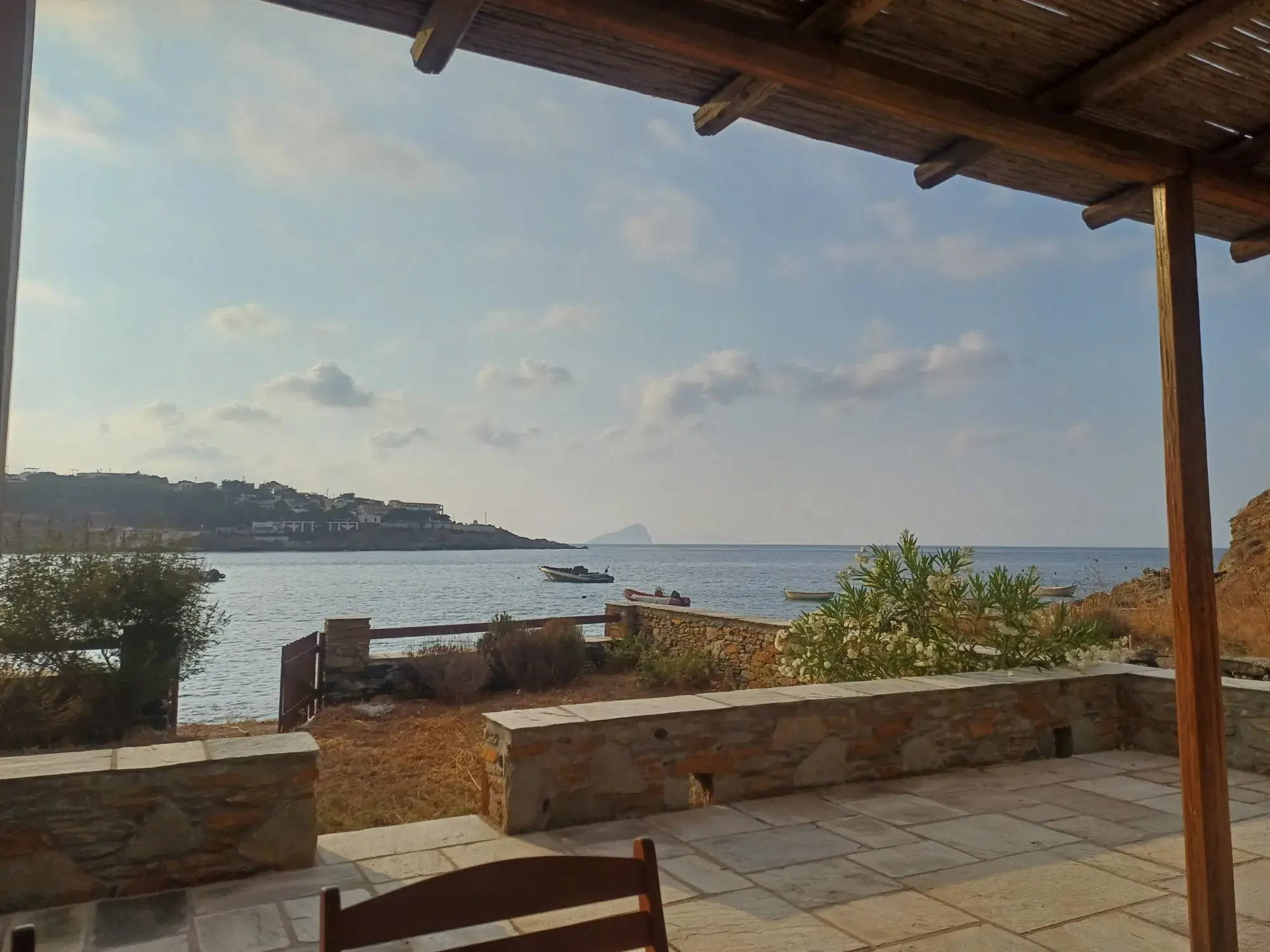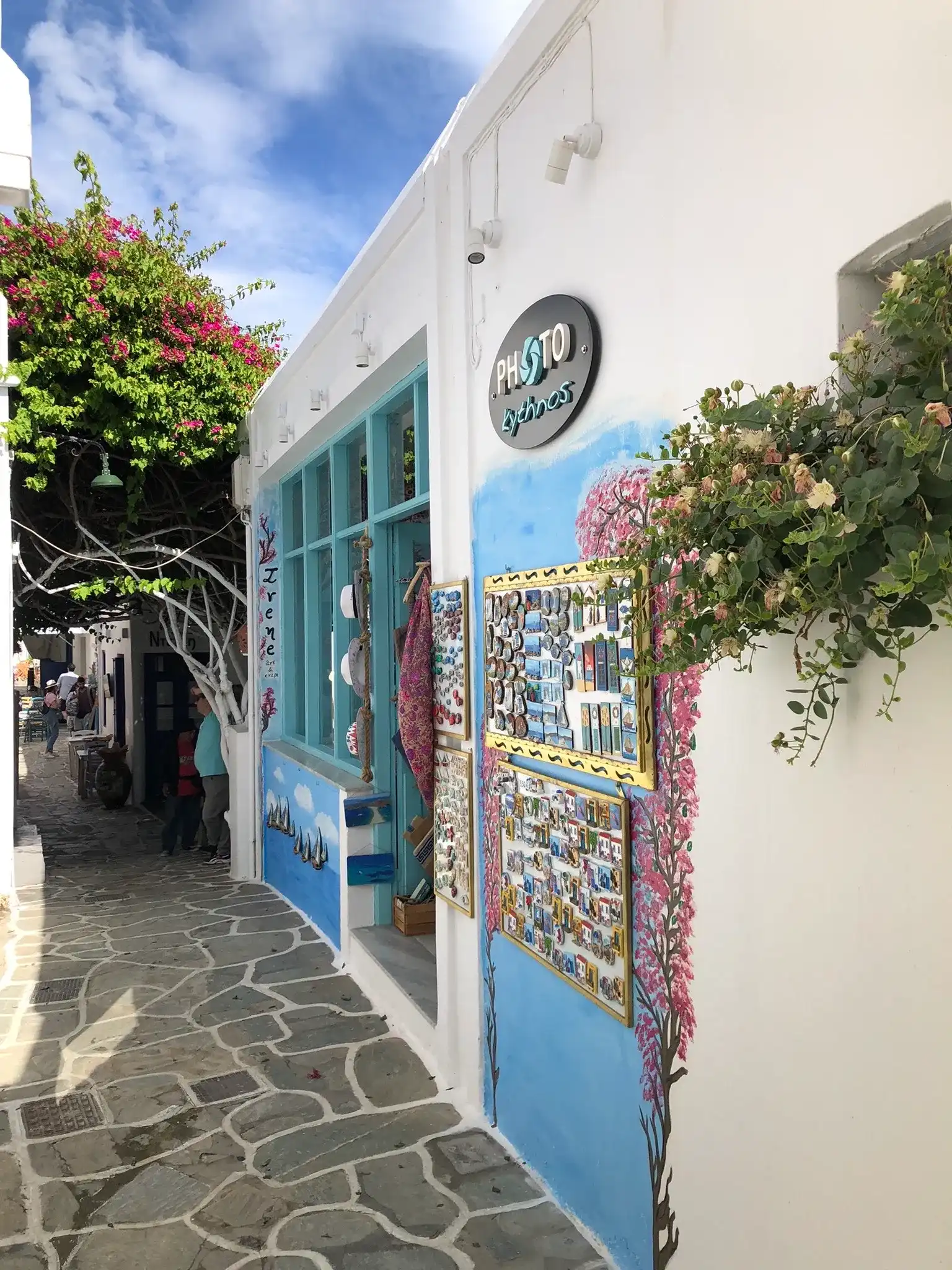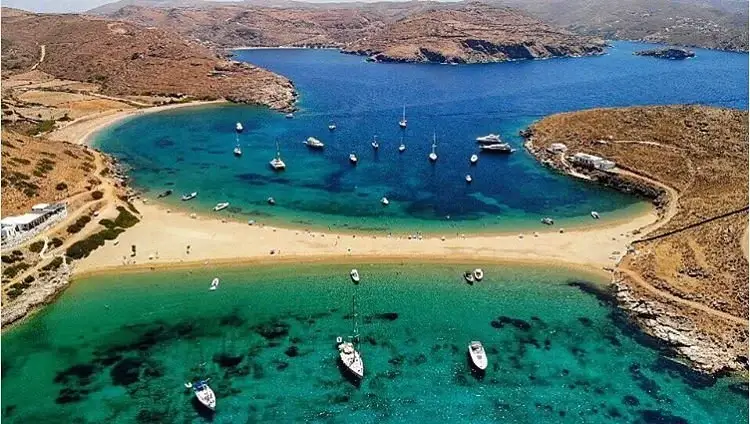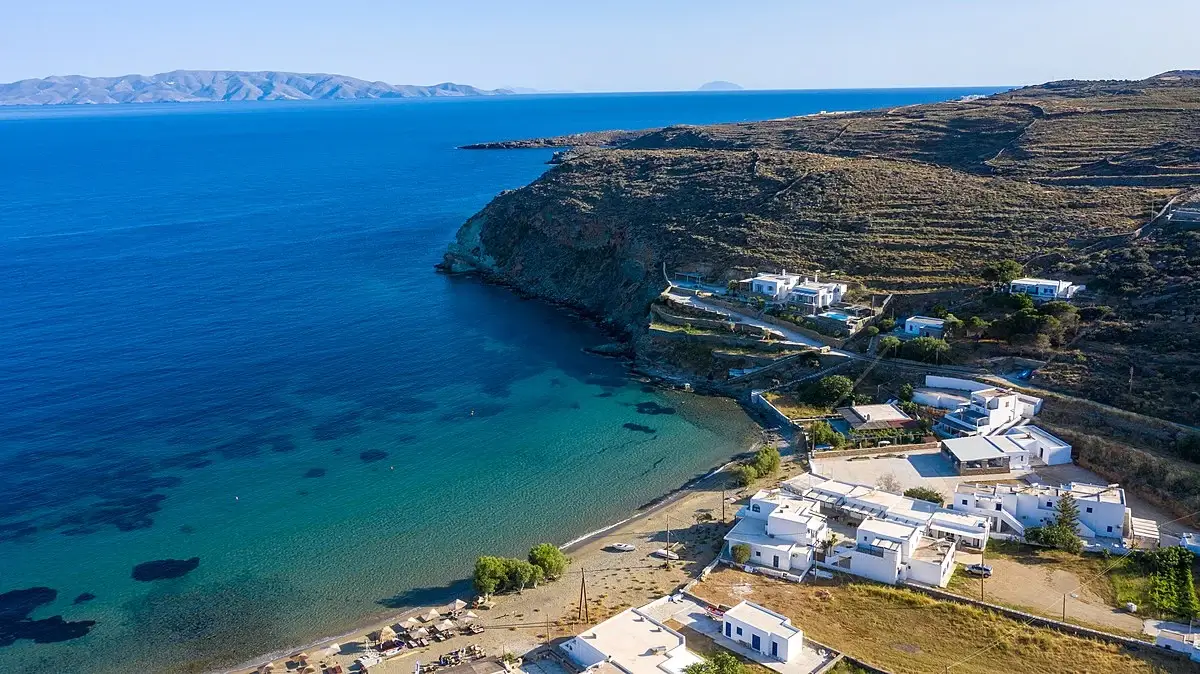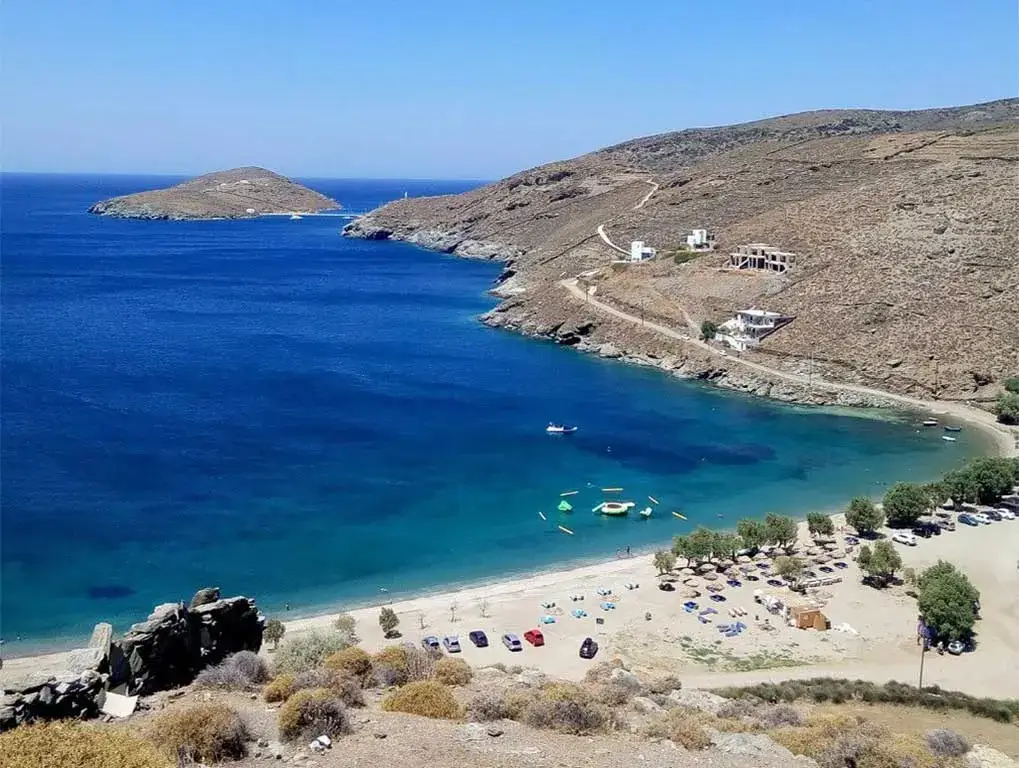Kythnos Island, Cyclades, Greece: Full guide
Kythnos. The island that hides its secrets in plain sight.
It’s quite remarkable how Kythnos, a Cycladic island located so close to the bustling capital of Athens, has remained one of the few untouched gems of the Aegean.
If Kythnos could stretch out its arms, it would touch Kea with one and Serifos with the other. On the map, it resembles a bird spreading its wings north and south, poised to soar from the deep blue waters of the Aegean and venture into the unknown, carrying with it its many treasures: idyllic beaches, stunning scenery, golden sunsets, green and colorful gardens, quaint churches, charming red-roofed houses, narrow alleys, solitary windmills, ancient history, archaeological sites, thermal springs, and above all, warm and welcoming locals
Let’s explore this special place…
The island has been known as Thermia since the 12th century A.D., a name inspired by its thermal springs, being able to offer therapeutic benefits but currently are under restoration..
Kythnos is just 56 nautical miles from Piraeus, a journey of about 2 hours and 40 minutes by modern ferry. From Lavrio port, the trip takes only around 2 hours.
The island, along with nearby islets, forms the municipality of Kythnos, which includes two main communities: Dryopida and Messaria. Part of the South Aegean’s Cyclades region, Kythnos covers an area of 100.2 sq.km. with a coastline of 104 km and has a population of about 1,456 residents.
Though not mountainous, Kythnos has a rugged, rocky landscape. Its highest point is Mount Petra (Profitis Elias), rising to 336 meters. Like much of the Cyclades, vegetation is sparse and limited to a few olive, fig, almond, and pear trees, along with bushes and traditional stone terraces (xerolithies). One notable exception is the pine forest near Panagia Kanala. Despite the arid conditions, locals carefully cultivate the land, producing high-quality products like the famed thyme honey. Fishing is also a key part of the local economy, with several fishing boats, ensuring a daily supply of fresh fish.
Across Greece, history is ever-present, and Kythnos is no exception. Archaeological findings date from the Neolithic period through to the Middle Ages. Traditional villages and time-honored customs enrich the island’s cultural landscape. The name Thermia, used in medieval times, highlights the island’s volcanic origins. At Loutra, the Romans developed a bathhouse that still stands in the main square. Its structure is impressive, with multiple rooms and large tubs stained by mineral deposits from centuries of use. The water—rich in iron, salt, and sulfur—is believed to help treat ailments such as arthritis, rheumatism, gynecological conditions, and gout.
Kythnos enjoys a mild Mediterranean climate, regarded as particularly healthy. Like all Cycladic islands, it is frequently swept by strong northern winds, which are harnessed for wind energy.
Traveling around the island reveals more than 92 beaches—mostly sandy, some rocky—tucked into coves both large and small. Many are accessible by car, especially those on the southern side. The northern coast is steeper and more rugged. Beaches are not organized with facilities, so natural shade from tamarisk trees provides refuge from the sun for those seeking peace and privacy.
Kythnos boasts numerous beaches, each with its own charm. The most striking of them all is Kolona Beach, a unique double-sided beach where a narrow strip of sand links Kythnos with the islet of Agios Loukas (St. Luke).
Visitors will find a wide selection of accommodations, from guesthouses to rental rooms, along with traditional tavernas, restaurants, cafes, and bars—everything needed for an enjoyable summer escape. One of the most breathtaking sunsets in the Cyclades can be experienced from Cape Markos.
In Chora (Messaria), a charming highlight is Messaria Square, a picturesque spot with lively cafes, ouzo-serving taverns, and a traditional church. When arriving on the island, the first village to greet visitors is Merichas, the island’s main port. Inland, Dryopida surprises with its distinctive red-tiled rooftops—an uncommon sight in the Cyclades.
Another highlight is Panagia Kanala, one of the most beloved villages of Kythnos. Surrounded by a rare pine forest, it offers an unexpected touch of green on the otherwise dry island. The coastal village of Loutra, home to the famous thermal springs, has developed into a popular spa destination thanks to its healing waters.
Kythnos is ideal for all kinds of sea-related summer activities—canoeing, kayaking, swimming, windsurfing, and more. The crystal-clear waters and underwater landscapes invite divers to explore hidden depths, while secluded coves provide peaceful spots for fishing and quiet relaxation.
The island is well-equipped to meet visitors’ needs for accommodation, leisure, and entertainment, celebrating family and social gatherings like christenings while making it a great choice for bachelor parties, destination weddings, and honeymoons
For hiking enthusiasts, Kythnos offers a network of traditional footpaths that wind through scenic landscapes and historical sites. The island also features a heliport for emergency or private transport.
Transportation
- From Piraeus, ferry crossings take about 3,5 hours.
(Info: Piraeus Port Authority – Tel. +30 210 4226000) - From Lavrio, the trip is shorter—about 1 hour 50 minutes, with service available year-round.
(Info: Lavrio Port Authority – Tel. +30 22920 25249)
Kythnos is also connected by ferry to neighboring islands:
- Daily connections with Serifos, Sifnos, Milos, and Kimolos
- Twice weekly to Santorini, Sikinos, and Folegandros
- Three times a week to Kea and Syros
Settlements
The island has two significant settlements, the village of Messaria or Chora of Kythnos (pop. 561 in 2011 census), known locally as Chora, and the village of Dryopis or Dryopida (pop. 325), also known as Chorio. Both villages are notable for their winding and often stepped streets, too narrow for vehicular traffic. The villages are very picturesque but have different architectural styles. Chora has the more-typical flat roofs of the Cyclades, while Dryopida’s rooftops are slanted and tiled. Chora is also notable for its large Greek Orthodox Church Panagia Nikous.
There is also a growing coastal settlement called Kanala on the east side of the island with the homonymous Panagia Kanala Christian Orthodox shrine in honor to the Holy Mother Mary, and many of the larger beaches are settled by a handful of residents. Aghios Dimitrios, at the southern tip of the island, is a mostly modern settlement, with small vacation houses spreading across the hillside above a wide beach that is dotted with sea daffodils. On the northeast end of the island lies Loutra (pop. 81), a village famous for its thermal springs, which are said to have curative properties. Although the large tourist hotel there has been closed for several years, the the large Loutra hotel next to the thermal springs is under renovation and although the bathhouse is springing into the nearby coast, it hasn’t finished its refurbishment yet, to be able to offer visitors a relaxing and therapeutic soak in its marble tubs.
The port town is called Merichas (pop. 369), its population significantly fluctuating during the year. Before the 1970s, there were no year-round residents in recent history; a Greek fisherman named Manolas Psaras and his wife Foto were the first to live in the port year-round. Today, there is a growing year-round population, and, especially during the peak of the summer tourist season, the town becomes quite busy. Many residents of the port speak at least some English, the most popular second language. Merihas is connected to Piraeus and to Lavrion by ferry boat, and the ride takes one to four hours, depending on the speed of the ship and the weather. Construction of a new mole began in 2005 to accommodate larger ferryboats and was completed in 2008. Kythnos was until recently considered to be one of the last Cycladic islands unaffected by the impact of tourism, but this is inexorably changing. Still, the island has not yet been overdeveloped, and in the more remote areas of the villages, traditional ways of living remain relatively unchanged.
Name
The first inhabitants of Kythnos were the Dryopes whose mythical king was Kythnos (son of the God Apollo), hence the name of the island. It was also known as Dryopis or Ofiousa. In the Middle Ages it was called Thiramna, while Nilos Doxapatris mentions it with the name Thermia as early as 1143, from the hot springs that exist. Later, the Turks called it “Hamam Antassi” (“island of warm waters”).
History
Pre-history
Kythnos can lay claim to one of the oldest known habitations in the Cycladic islands, a Mesolithic settlement (10000 BCE – 8000 BCE) at Maroulas on the northeast coast. The site, close to the village of Loutra, is situated on the shore, and large portions have eroded into the sea. Excavations in 1996 found intact human skeletons, along with stone artifacts and part of a floor pavement, which indicates a long-term settlement, probably of hunter-gatherers.
Pre-classical antiquity
Third millennium BCE (First Cycladic Period) findings at Skouries near the highest peak of the island, Mt. Profitis Elias, suggest that Kythnos was a supplier of raw materials for metallurgy to other islands during the Bronze Age. Remains of copper smelting sites and open-air copper mines were investigated in 1984–1985. (A recent paper by Myrto Georgakopoulo points to the seminal work here by Gale and others.)
The earliest inhabitants of the island known to historians were the Kares (Carians), an Anatolian people probably allied to or under the dominion of the Minoans, who eventually were forced by pressure of invading tribes to move on and settle in Asia Minor. Herodotus (Bk. viii, 73) records that in the 13th century BCE, another pre-Hellenic tribe, the Dryopes, originally from the Greek mainland near Mount Parnassus, migrated to the islands, first to Euboea and later spreading to Kea, Kythnos, and beyond. This tribe most probably gave rise to the name of one of the two main villages, Dryopis or Dryopida. Some sources say the island took its name from King Kythnos of the Dryopes; others suggest this is a mythical rather than a historical figure. (Speculations on the origin of the name are contained in Vallinda, 1896.) The Dryopes eventually moved on as well under pressure from Ionians, who migrated out of mainland Greece as Dorian tribes moved in from the north.
A Hellenistic site at Vryokastro, above the bay of Episkopi on the northwest part of the island, was partially excavated in the mid-20th century, yielding floor plans of houses and a sanctuary, as well as a few artifacts. In Greek newspaper articles of December 19, 2002, archaeologist Alexandros Mazarakis-Ainian announced a spectacular discovery on this site: an inner sanctum (adyton) of the temple was found intact and unplundered. Over 1,400 objects, including precious jewels and gold, silver and bronze artifacts, terracotta figurines, and painted vases, were excavated from what the archaeologists have determined is a 2,700-year-old temple dedicated to either Hera, queen of the gods, or Aphrodite, goddess of love. The artifacts date mostly from the 7th to the 5th centuries BCE. The site at Vryokastro was inhabited until Roman times. In this era, the islands of the Cyclades suffered frequent predation by pirates, and perhaps for this reason, the main settlements moved inland and to more defensible locations.
Remains of another old settlement, with extensive stone walls, can be seen in the extreme northern headland. This site, called Kastro (Greek for Castle), was likely the capital of the island from about the 1st century through the Byzantine era and into Frankish times. This site seems nearly impregnable: on three sides is a sheer 500-foot (150 m) drop to the sea. The fourth side is approached via a narrow track, which was barricaded with a thick, high wall, parts of which are still extant (along with walls delineating hundreds of houses). Nevertheless, there is evidence that the town was destroyed and rebuilt several times. The population fluctuated dramatically during this period and at times the island was decimated due to marauders and plague (Smith, 1854 and Bent, 1885, reprinted 2002).
Classical antiquity
Only rarely is the island mentioned by ancient authors. In the Battle of Salamis (480 BCE), Herodotus records that Kythnos contributed a trireme and a penteconter, and this contribution is commemorated on the base of a golden tripod at Delphi (Herodotus, Bk viii, 46).
Innumerable sources repeat, without providing a citation, that Aristotle praised the government of Kythnos in his “Constitution of Kythnos.” Exactly what he wrote is difficult to ascertain, since all of his essays on the constitutions of 158 city-states are lost except for the one on Athens. (Possibly, the origin of the quote is from the 2nd century lexicographer Harpocration.)
In the Roman period Kythnos was a place of exile for important persons. In addition, in antiquity there were several temples on the island, which resulted in the island being visited by travelers from various regions (e.g. Egypt, Asia Minor, Italy, etc.). The painters Timanthis and Cydias were born in Kythnos in antiquity. Later Kythnos became part of the Byzantine Empire.
Crusader and Venetian Era
In 1207, Kythnos was annexed to the Frankish overlord Marco Sanudo’s Aegean Duchy of the Archipelago (or of Naxos). During this period, it was known as Thermia, a name derived from the hot mineral springs occurring on the northeastern coast at the village of Loutra (which means “baths” in Greek). These medicinal baths were renowned at least since Roman times and were a fashionable spa and resort area.
The island was ruled as an appanage of the Duchy of the Archipelago from the 16th century until the fall of the Duchy, where it became de facto independent.
In 1600, Thermia also became the new name of a Latin bishopric on the Cyclades, formerly known as Roman Catholic Diocese of Ceo (now a Latin Catholic titular see).
The island capital remained at Kastro of Oria or Katakefalo, which was rebuilt as a Frankish fortress and was known as the Tower of Thermia (Bent, 1885, reprinted 2002).
After a period of depopulation in the early 15th century some Albanian communities moved from nearby Euboea. They were assimilated into the local Greek population.
Ottoman Era
Following a siege, the Turks were victorious over the last Venetian overlord, Angelo III Gozzadini, in 1617. According to a myth recounted by Theodore Bent in his 1885 travelogue on the Cyclades, Kastro fell only because of a treacherous ploy by the Turks: a young woman, heavy with child and apparently in pain, approached the entrance and begged to be admitted; the watchman’s daughter opened the gate for her—and for the Turks hiding nearby. Bent writes that this version is preserved in a popular island ballad.
After its fall to the Turks, Kastro was abandoned and the new capital was located inland, as the name Messaria suggests. Later, this town became known as Hora (the generic Greek name for a capital town, also spelled Chora). During this period Kythnos was a poor, under-populated place, still beset by pirates and suffering frequent epidemics.
In 1791 a Greek school was opened in Chora (Messaria), which was housed in the monastery of Panagia of Nikous. The monk Parthenios Koulouris from Sifnos initially taught there. He was succeeded in 1809 by the monk Makarios Filippaios from Kythnos, who continued teaching during the years of Ioannis Kapodistrias.
In 1806 a pirate raid, although repelled, resulted in groups of locals emigrating to the coast of Asia Minor, from where some later repatriated, bringing back customs to the island from the places where they had lived.
Kythnos took part in the 1821 Revolution and during its duration was a safe haven for Greek refugees from areas such as Chios, Psara and Aivali. In 1823 a plague broke out. Kythnos was represented in the 3rd National Assembly of Epidaurus, in the 3rd National Assembly of Troizina by Moschos Filippaios (Chora) and N. Economidis Levantis (Dryopida). In the following years until 1832 Kythnos was represented in the National Assemblies by N. Vallindas.
Modern Kythnos
In 1828 five schools were operating on the island, including private schools, and by 1833 there were only two schools operating. They were financially supported by contributions from the residents and income from monasteries on the island. During the reign of King Othon, Kythnos was a place of exile for political prisoners and was the scene of an unsuccessful revolt in 1862 by rebels from Syros who attempted to free the prisoners.
In the 19th century, Kythnians mainly earned their living as they had for centuries before: as countrymen,or by fishing. The island had few natural resources and, lacking a deep-water mooring for boats, was relatively inaccessible. On the other hand ceramics and pottery flourished in Kythnos, with Kythnian craftsmen leaving for Athens in the spring and returning in the winter.
At the beginning of the 20th century the production of high quality barley and semolina increased greatly and exports increased accordingly. As the new century dawned, iron ore was discovered on the island and Kythnians were able to supplement their meager incomes by working in the mines. These mines, however, were mostly played out by World War II, and once again, the population of the island went into decline, as young people left to find employment and a better life in Athens or even further afield. During the Axis Occupation of Greece, many Kythnians living in Athens returned to the island for better living conditions.
The Greek tourist boom beginning in the mid-20th century largely bypassed Kythnos because its harbor lacked a deep-water dock for ferryboats. The construction of a new ferry dock in 1974 brought great changes. Today, the island is a modern, prosperous place, with a burgeoning tourist trade. It is in the forefront of alternative energy experiments, with the establishment in 1982 of Greece’s first wind park. With the addition of a photovoltaic system and storage batteries, the amount of diesel fuel required to supply the island’s electricity has been reduced by 11%. Numerous individual houses on remote coves are equipped with photovoltaic systems, and nearly all houses employ solar water heaters.
Due to its proximity to Athens, Kythnos has become a fashionable setting for vacation homes, in addition to being an accessible destination for foreign visitors. Besides its numerous beaches and picturesque villages, it also is the site of one of the largest caves in Greece, Katafyki Cave in Dryopida. This cave, first visited in the 1830s and described by the geologist Fiedler, has unique “schratten” or rock curtains, as well as speleotherms. It was the site of an iron mine until 1939 and has now been developed as a tourist attraction.
In 2023, Kythnos celebrated the inauguration of the Archaeological Museum of Kythnos, a long-awaited dream for the island’s inhabitants. It is housed in the old, Single Classroom Primary School of Chora, Kythnos, and along its exhibits visitors may find an Archaic temple treasure with various golden and precious metals offerings, plus 7th to early 5th century BC objects.
The violin and the lute are the main musical instruments of the island, which form the “Zyas”, as they are called on the island. The tsampouna (or kaida) is the characteristic instrument heard on Carnival.
Traditions
In the legends and beliefs of Kythnos there are multiple references to fairies, vampires, dragons etc. living in various places on the island such as: ancient ruins, mills, threshing floors, isolated beaches etc.
Gastronomy
Representative dishes of the local cuisine are sfougata (fried cheese balls), kolopi (pita mainly with spinach) and poulos (a bread roll filled with salted pork). The island also has other traditional products such as thyme honeyand various types of cheese.
Beaches
Kythnos has more than 90 beaches, many of which are still inaccessible by road. Of particular note is the crescent-shaped isthmus of fine sand at Kolona. Other beaches are: Episkopi, Apokrousi, Megali Ammos, Flambouria, Schinari, Simousi, Martinakia, Zogaki, Naoussa, Kouri, Agios Stefanos, Vasilika, Lefkes & Liotrivi.
Notable people
- Timanthes (4th century BC), painter
- Ignatius of Mariupol (1716–1786), bishop, founder of Mariupol
- Giorgos Zambetas 1925–1992, composer
- Leonidas Paraskevopoulos, military officer
In popular culture
Clive Barker’s story Babel’s Children is set in Kythnos.
Have Fun in Kythnos
As soon as you arrive in Kythnos, you’ll discover a charming mountainous island nestled between Kea (Tzia) and Serifos. Despite its proximity to Athens, Kythnos has managed to preserve its natural beauty and authentic Cycladic character. During your stay, you’ll not only enjoy stunning beaches but also a variety of options for relaxation and entertainment.
The locals are warm and welcoming—don’t be surprised if someone invites you for a coffee or a glass of ouzo, along with a taste of traditional dishes, tyrovoli (soft cheese mixed with eggs), and kopanisti (spicy mashed cheese).
As you wander through the island’s villages, the whitewashed houses, typical of Cycladic architecture, will enchant you. Stroll along the cobblestone streets and admire the stone arches and fountains, the lime-painted courtyards, and the charming alleys often decorated with island-inspired motifs.
Take a break in one of the cozy cafes or tavernas, where you can enjoy a relaxing meal or drink in a peaceful setting. If you’re in the mood for nightlife, Kythnos won’t disappoint—its bars and clubs offer lively music and dancing, often lasting until the early hours of the morning.
Whether you’re seeking quiet moments or lively nights out, Kythnos offers fun for everyone—with beauty, hospitality, and tradition around every corner.
During your visit at Kythnos you should definitely visit the hot springs or even the beautiful beach of Loutra where the springs are streaming into the sea which will make you feel euphoric thus having a great mood!
Hiking in the impressive landscape of the island and climb to the most remote places with spectacular views. If you bike, wander the mountain roads and trails of the island. Kythnos is offered for those sports related to the summer and the sea. Canoeing, kayaking, swimming and windsurfing on the beautiful beaches. Unique diving in depths that are waiting to discover their secrets. Fishing and relaxation in desert places, where only the waves can be heard.
There are specialized professionals in Kythnos organizing daily diving trips, shore excursions that include routes jeep, hiking or mountain biking, and relaxing sightseeing of the island and excursions by boat to secluded beaches for swimming and Picnicking.
Source: Municipality of Kythnos

